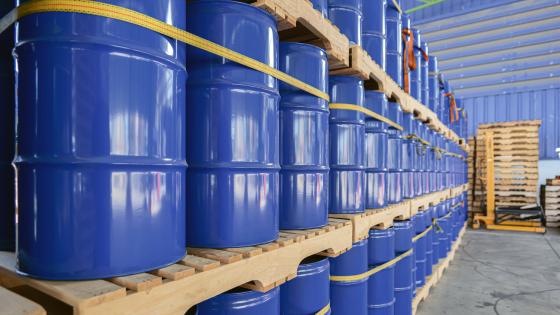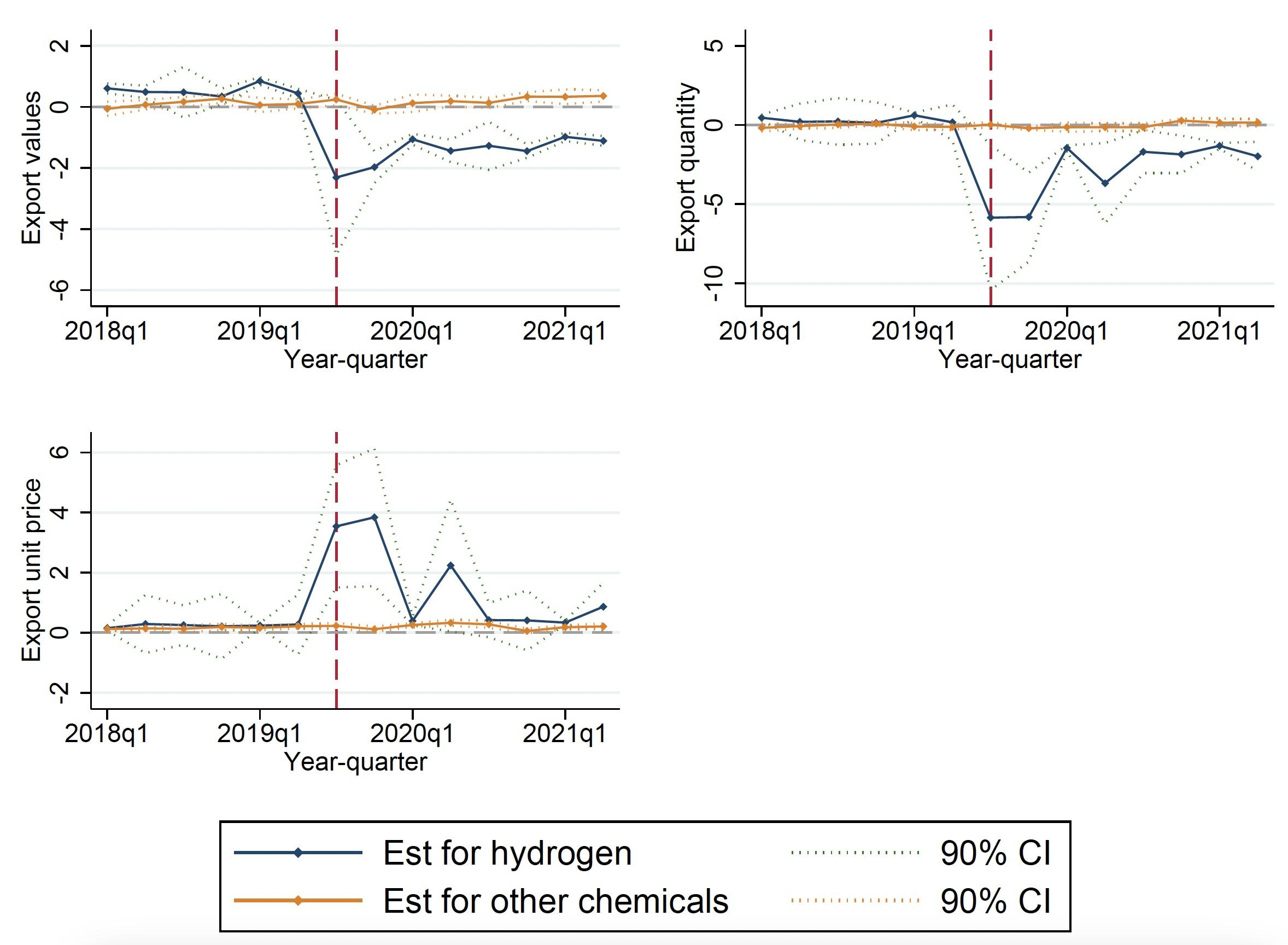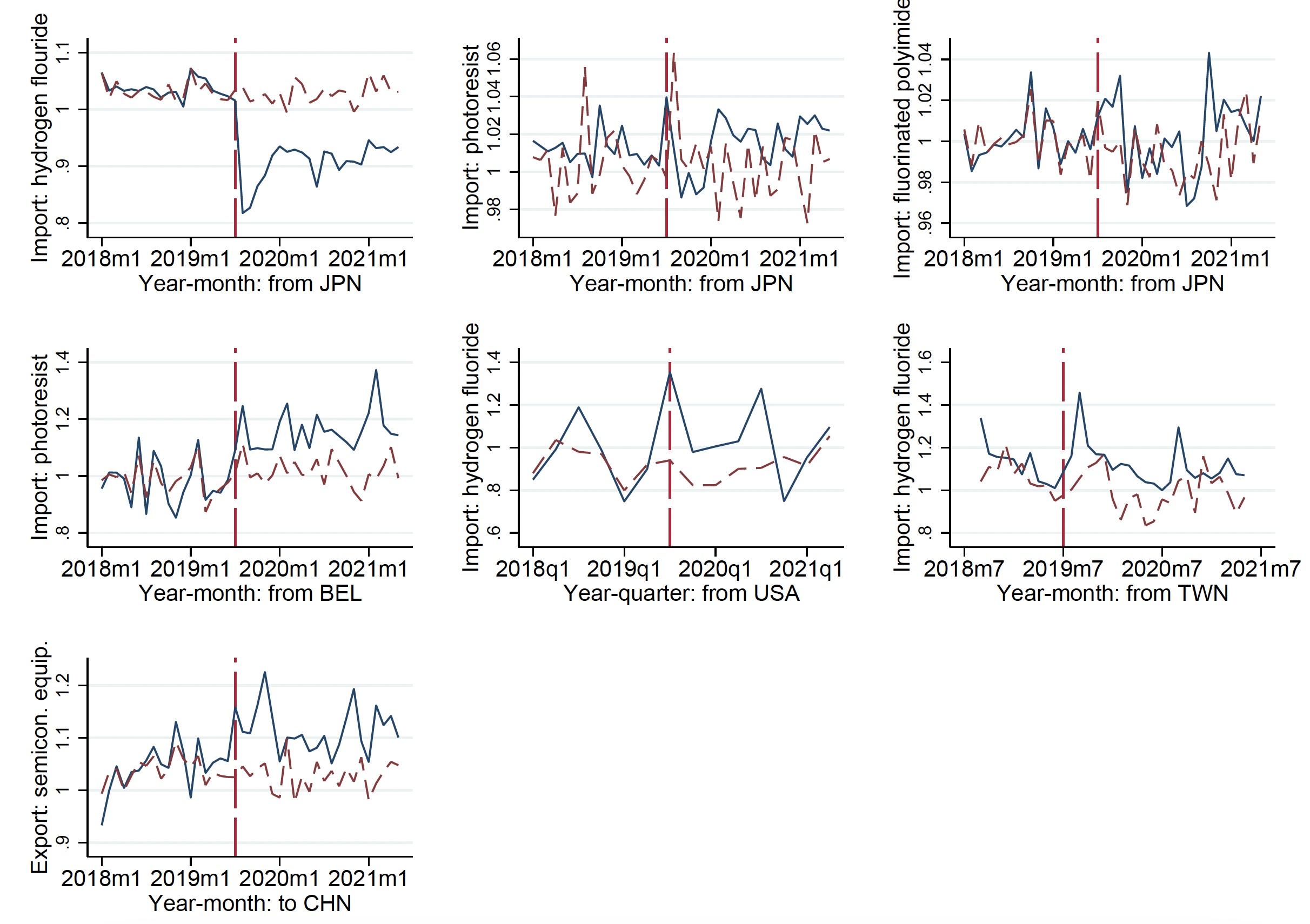Trade policy being used to address national security concerns has been pervasive in recent years. Notable examples are the US trade restrictions against China in 2018, the US trade sanctions against Russia following its invasion of Ukraine in 2022, and the US export controls on the Chinese semiconductor industry in 2019. Research on trade policies has also been growing over the last ten years (e.g. Amiti et al. 2019, Fajgelbaum et al. 2020, Bown 2021, Fajgelbaum et al. 2021, Latipov et al. 2022, Hayakawa et al. 2023). While most of the research analyses the effect of tariffs on domestic economies, there is still relatively little empirical evidence on the effect of non-tariff trade policy on exports and imports in an industry with extensive global value chains (GVCs). What is the effect of such trade policy on international trade in an industry where the production process is characterised by global value chains? Is unilateral export control effective in an industry where firms change their production and sourcing patterns in response to export controls? In a recent paper (Makioka and Zhang 2023), we investigate the effect of non-tariff trade policy implemented in the name of national security on international trade in an industry characterised by global value chains – the semiconductor industry. We use a recent Japan–Korea trade dispute as a case study.
In July 2019, the Japanese government announced potential export controls on South Korea for three chemical inputs, namely hydrogen fluoride, photoresist, and fluorinated polyimide, all of which are essential in semiconductor production. As a result, Japanese exporters of these three chemical materials are required to apply for individual export licenses, rather than bulk export licenses, reporting information on end-user, product specifications, technology, and so on for each export contract. The semiconductor industry has what is a typical example of a global value chain. The US, Taiwan, and China have dominant sales shares in all design, manufacturing, and outsourced semiconductor assembly and test (OSAT) stages, while the design stage itself tends to be located in Europe and Japan, the manufacturing stage in Israel and South Korea, and the OSAT stage in Singapore and Japan. Given its sequential features, protectionist trade measures can potentially affect the entire production process and input sourcing patterns.
The semiconductor industry in South Korea was heavily dependent on these three chemical materials imported from Japan before the Japanese export control was introduced. For instance, Japanese firms supply more than 90% of South Korean imports of two out of the three key materials. The materials are then used in semiconductor production in South Korea, which comprises 20% of South Korea’s total exports. We use a difference-in-differences approach and the synthetic control method to determine the causal effect of the export control on Japanese export, and Korean import and export. We also provide some preliminary statistics to investigate the response of domestic production in Japan and South Korea to the export controls.
Findings
There are five findings. First, the Japanese exports of hydrogen fluoride to South Korea declined by 87.9% due to the export control, but this was not the case for the other two restricted chemical materials, photoresist and fluorinated polyimide (Figure 1). The latter could be partly because the Japanese Ministry of Economy, Trade and Industry allowed, in December 2019, three-year bulk export licenses for some photoresist transactions.
Figure 1 Effects of the export controls on the Japanese exports of three chemical materials to South Korea
Note: This figure plots the coefficients on the triple interactions of year-quarter, South Korea, and product dummies as in the even columns in Table 6 in Makioka and Zhang (2023), but using the year-quarter aggregated data and including product-country-month fixed effects. The coefficients are thus estimated with respect to their respective values in the year 2017 (all 12 months of 2017 are omitted). The vertical dashed line corresponds to the third quarter in 2019 when the export control was enacted.
Second, the restrictions increased Japanese exports of hydrogen fluoride to the US, and thus did not cause, on average, a decrease in the Japanese production of semiconductor-related products. It also suggests the possibility that Japanese firms substituted their exports of restricted chemical materials to the US or exported the materials to South Korea through the US (roundabout trade). The latter possibility is consistent with the next finding.
Third, South Korea increased their import of hydrogen fluoride from the US and Taiwan and those of photoresist from Belgium, which is consistent with their reallocation of input sourcing from Japan to economies such as Belgium, the US, and Taiwan (the middle graph in Figure 2). Furthermore, their imports of semiconductor manufacturing equipment dropped from the Netherlands by 54.7% and from Germany by 72.6% respectively. This could reflect the fact that semiconductor manufacturing equipment, that is used complementarily with chemical materials in the production process, is no longer purchased due to the Japanese export restrictions of the chemical materials. Actually, a company in the Netherlands, ASML, supplies 75% of lithography (one of the production steps in semiconductor products) equipment in the global market and is the only company supplying extreme-ultraviolet lithography equipment in the world, which is required to produce the most advanced chips. On the other hand, high-quality photoresist is also used in the extreme-ultraviolet lithography step, which is restricted due to the Japanese export control. Semiconductor manufacturing plants need to combine the material with the equipment to produce semiconductor wafers.
Figure 2 Effects of the export controls on South Korean imports and exports
Note: The figure plots the results of the synthetic control method for South Korean imports of hydrogen fluoride from Japan (top left), their imports of photoresist from Japan (top middle), their imports of fluorinated polyimide from Japan (top right), their imports of photoresist from Belgium (middle left), their imports of hydrogen fluoride from the US (middle middle), their imposts of hydrogen fluoride from Taiwan, and their exports of semiconductor manufacturing equipment to China (bottom left). Within each window, the blue line is the log import values or log export values for each treatment group. The red dashed line is the corresponding values for the synthetic control group. The vertical red line denotes the timing of the Japanese export controls (July 2019 or third quarter in 2019).
Fourth, the South Korean exports of semiconductor manufacturing equipment to China seem to increase substantially at the time of the introduction of the Japanese export controls (bottom left in Figure 2). This is consistent with the interpretation that these South Korean firms reallocate some of their production to China to securely source the necessary chemical materials under the export controls and require shipment of semiconductor manufacturing equipment to China.
Fifth, the production of the three chemical materials increased in Korean firms and Japanese affiliates in South Korea after the export controls. The former is consistent with the fact that the South Korean government announced 7.8 trillion won (about $6 billion) of investment over seven years to promote domestic production of strategic products (including the three chemical materials) in August 2019. In addition, the latter is consistent with the story that Japanese multinational enterprises (MNEs) shifted their production of these three chemical materials due to the export controls.
Conclusion
In the modern global economy where global value chains are pervasive, trade policies for national security purposes can face unintended consequences through changes in firm’s sourcing strategy, production locations, and production decisions of multinational enterprises. This result suggests that the effectiveness of unilateral export controls is limited in the current global economy. Taking these effects into account when making policy decisions is necessary to mitigate the unintended negative effects of such policies. Further research should be done especially by using more detailed firm-level data to pin down the mechanisms.
Editor’s note: The main research on which this column is based (Makioka and Zhang 2023) first appeared as a Discussion Paper of the Research Institute of Economy, Trade and Industry (RIETI) of Japan.
References
Amiti, M, S Redding and D Weinstein (2019), “The Impact of the 2018 Tariffs on Prices and Welfare", Journal of Economic Perspectives 33(4): 187-210.
Bown, C P (2020), “How the United States Marched the Semiconductor Industry into its Trade War with China”, East Asian Economic Review 24(4): 349-388.
Fajgelbaum, P, P Goldberg, P Kennedy and A Khandelwal (2020), “The Return to Protectionism", Quarterly Journal of Economics 135(1): 1-55.
Fajgelbaum, P, P Goldberg, P Kennedy, A Khandelwal and D Taglioni (2021), “The US-China Trade War and Global Reallocations”, Working Paper.
Hayakawa, K, K Ito, K Fukao and I Deseatnicov (2023), “The Impact of the Strengthening of Export Controls on Japanese Exports of Dual-use Goods”, International Economics 174: 160-179.
Latipov, O, C Lau, K Mahlstein and S Schropp (2022), “Quantifying the impact of the latest U.S. tariff sanctions on Russia - a sectoral analysis”, IIEP Working Paper 2022-08, The George Washington University, Institute for International Economic Policy.
Makioka, R and H Zhang (2023), “The Impact of Export Controls on International Trade: Evidence from the Japan-Korea Trade Dispute in the Semiconductor Industry”, RIETI Discussion Paper Series 23-E-017.





